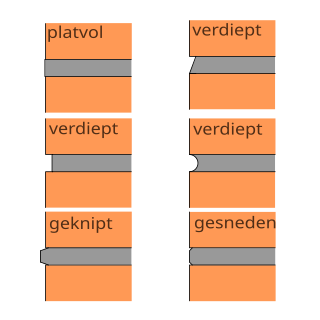
Masonry is the building of structures from individual units, which are often laid in and bound together by mortar; the term masonry can also refer to the units themselves. The common materials of masonry construction are brick, building stone such as marble, granite, travertine, and limestone, cast stone, concrete block, glass block, and adobe. Masonry is generally a highly durable form of construction. However, the materials used, the quality of the mortar and workmanship, and the pattern in which the units are assembled can substantially affect the durability of the overall masonry construction. A person who constructs masonry is called a mason or bricklayer. These are both classified as construction trades.

The Wall is the eleventh studio album by English rock band Pink Floyd, released in 1979 through Harvest and Columbia Records. Conceived during the In The Flesh tour, recording spanned nearly a year, from December 1978 to November 1979, and took place in France, England, New York, and Los Angeles. It was produced by Bob Erzin, who helped to refine the concept and bridge tensions during recording. Some of the outtakes from the recording sessions were used on the band's next album, The Final Cut (1983).

Brickwork is masonry produced by a bricklayer, using bricks and mortar. Typically, rows of bricks—called courses— are laid on top of one another to build up a structure such as a brick wall.

Building material is any material which is used for construction purposes. Many naturally occurring substances, such as clay, rocks, sand, and wood, even twigs and leaves, have been used to construct buildings. Apart from naturally occurring materials, many man-made products are in use, some more and some less synthetic. The manufacturing of building materials is an established industry in many countries and the use of these materials is typically segmented into specific specialty trades, such as carpentry, insulation, plumbing, and roofing work. They provide the make-up of habitats and structures including homes.

Under Wraps is the 15th studio album by the band Jethro Tull, released in 1984. The songs' subject matter is heavily influenced by bandleader Ian Anderson's love of espionage fiction. It was controversial among fans of the band due to its electronic/synthesizer-based sound, particularly the use of electronic drums. Dave Pegg has been quoted as saying that the tracks cut from the sessions for Broadsword and the Beast would have made a better album, while Martin Barre has referred to it as one of his personal favourite Tull albums. The album reached No. 76 on the Billboard 200 and No. 18 on the UK charts. The single "Lap of Luxury" reached No. 30.

The Primitives are an English indie pop band from Coventry, best known for their 1988 international hit single "Crash". Formed in 1984, disbanded in 1992 and reformed in 2009, the band's two constant members throughout their recording career have been vocalist Tracy Tracy and guitarist Paul Court. Drummer Tig Williams has been a constant member since 1987 and the reformed line-up is completed by bassist Raph Moore. Often described as an indie pop or indie rock band, The Primitives' musical style can also be seen as straddling power pop, new wave and post-punk.

A concrete masonry unit (CMU) is a standard size rectangular block used in building construction. CMUs are some of the most versatile building products available because of the wide variety of appearances that can be achieved using concrete masonry units.

Goodbye Yellow Brick Road is the seventh studio album by Elton John, released in 1973. The album has sold more than 30 million copies worldwide and is widely regarded as John's best. It was recorded at the Château d'Hérouville in France after problems recording at the intended location in Jamaica. Among the 17 tracks, the album contains the hits "Candle in the Wind", "Bennie and the Jets", "Goodbye Yellow Brick Road" and "Saturday Night's Alright for Fighting" plus "Funeral for a Friend/Love Lies Bleeding" and "Harmony".

Repointing is the process of renewing the pointing, which is the external part of mortar joints, in masonry construction. Over time, weathering and decay cause voids in the joints between masonry units, usually in bricks, allowing the undesirable entrance of water. Water entering through these voids can cause significant damage through frost weathering and from salt dissolution and deposition. Repointing is also called pointing, or pointing up, although these terms more properly refer to the finishing step in new construction.
A brick is an artificial stone made by forming clay into hardened rectangular blocks.

Lime mortar is composed of lime and an aggregate such as sand, mixed with water. The Ancient Egyptians were the first to use lime mortars. About 6,000 years ago, they used lime to plaster the pyramids at Giza. In addition, the Egyptians also incorporated various limes into their religious temples as well as their homes. Indian traditional structures built with lime mortar, which are more than 4,000 years old like Mohenjo-daro is still a heritage monument of Indus valley civilization in Pakistan. It is one of the oldest known types of mortar also used in ancient Rome and Greece, when it largely replaced the clay and gypsum mortars common to ancient Egyptian construction.

Direction Reaction Creation is an anthology issued in 1997 by the British band The Jam. It includes 117 tracks over 5 discs, including all of the songs from their singles and six studio albums. The box set reached #8 in the UK Album Chart.

"Brick House" is a song from the Commodores' 1977 self-titled album. The single peaked at #5 in the U.S. and #32 in the UK Singles Chart.

Baby Snakes is the soundtrack to Frank Zappa's film of the same name. It features several of the songs from the film and was originally released as a picture disc.

A course is a layer of the same unit running horizontally in a wall. It can also be defined as a continuous row of any masonry unit such as bricks, concrete masonry units (CMU), stone, shingles, tiles, etc.

In masonry, mortar joints are the spaces between bricks, concrete blocks, or glass blocks, that are filled with mortar or grout. If the surface of the masonry remains unplastered, the joints contribute significantly to the appearance of the masonry. Mortar joints can be made in a series of different fashions, but the most common ones are raked, grapevine, extruded, concave, V, struck, flush, weathered and beaded.
Brick + Mortar is an indie rock duo founded in Toms River, New Jersey in March 2008. The duo consists of frontman Brandon Asraf and John Tacon. The two members have garnered a notable amount of regional success since their formation. They were signed to Photo Finish Records / Island Def Jam Records, and then Merovee Records / ADA, but now currently have distribution through Believe Recordings.


















